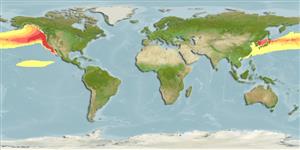Common names from other countries
Classification / Names / Names
Common names | Synonyms | Catalog of Fishes (gen., sp.) | ITIS | CoL | WoRMS
Environment: milieu / climate zone / depth range / distribution range
Ecology
Pelagic. Subtropical; 90°N - 10°N, 180°W - 180°E
Pacific Ocean: Eastward across the Pacific between 34° and 47°N, extending north to 55°N, 145°W, in the Gulf of Alaska (Ref. 1522).
Length at first maturity / Size / Weight / Age
Maturity: Lm ? range ? - ? cm Max length : 310 cm TL male/unsexed; (Ref. 1394); 230 cm TL (female); max. published weight: 115.0 kg (Ref. 1394)
Inhabits cold and warm temperate regions. Feeds on squid and lanternfish; but also feeds on a variety of surface and mid-water species (Ref. 1394).
Jefferson, T.A., S. Leatherwood and M.A. Webber. 1993. (Ref. 1394)
IUCN Red List Status (Ref. 130435: Version 2024-1)
CITES status (Ref. 108899)
Not Evaluated
Human uses
Fisheries: commercial
FAO - Fisheries: landings, species profile | FishSource | Sea Around Us
Tools
More information
Age/Size
Growth
Length-weight
Length-length
Morphology
Larvae
Abundance
Internet sources
Estimates based on models
Preferred temperature
(Ref.
115969): 1.2 - 2.5, mean 1.6 (based on 1017 cells).
Vulnerability
Very high vulnerability (90 of 100).
Price category
Unknown.
